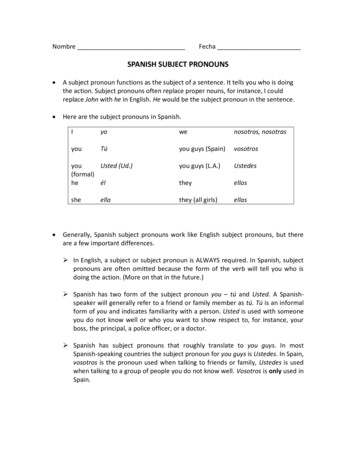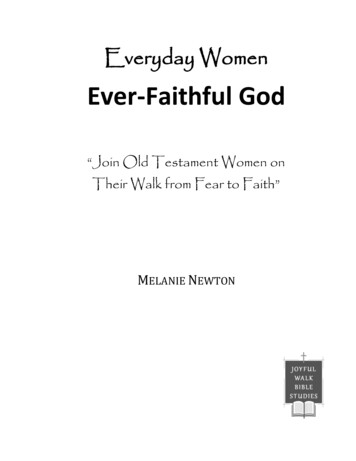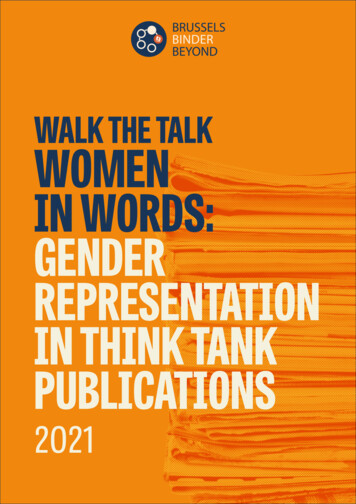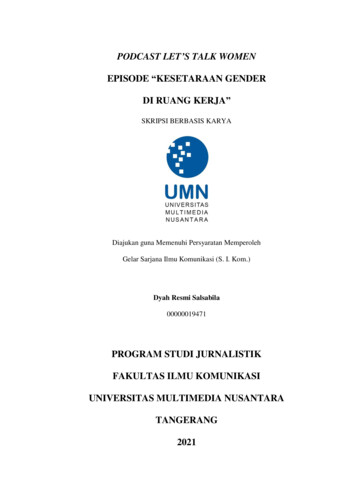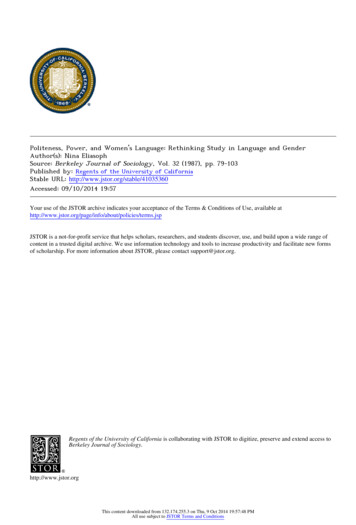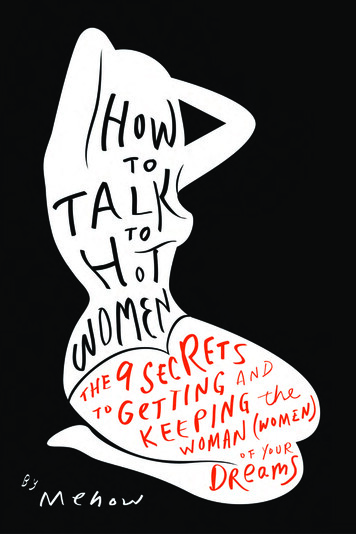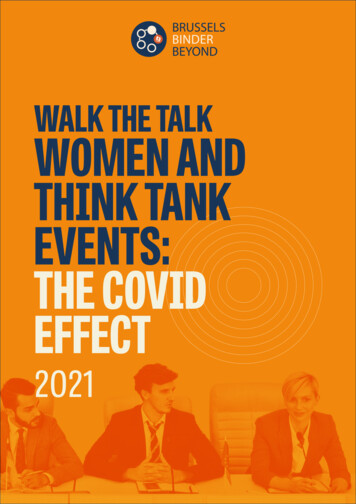
Transcription
WALK THE TALKWOMEN ANDTHINK TANKEVENTS:THE COVIDEFFECT2021
The Brussels Binder BeyondMORE WOMEN’S VOICES IN EUROPEAN DEBATESSupported by the European Commission, Brussels Binder Beyond (BBBeyond) builtupon The Brussels Binder initiative with the idea to bring the efforts of The BrusselsBinder “Beyond” Brussels and across Europe.BBBeyond aimed to achieve the following objectives:1) build and cultivate a pan-European network of women expert databases, thinktanks, and like-minded organisations to raise awareness of the issue of underrepresentation of women and create synergies to promote women’s visibility;2) build and maintain an online repository of women expert databases; and3) co-create practical tools for diverse and innovative convening.By fostering an inclusive and solution-focused environment for knowledge transferand best practice exchange, BBBeyond has facilitated community-building activitiesthat focus on co-creation and peer-learning for the development of quality controltools and recommendations for diverse and innovative convening.As part of the project, the BBBeyond network as notably inventoried women expertdatabases all over the world on an interactive map. We have also published sixtoolkits to support organisations and individuals in their diversity efforts. Head towww.brusselsbinder.org/bbbeyond to find out more about these tools.www.brusselsbinder.orgDATA COLLECTION:Sabrine Dao, Eleonora del Vecchio, Sophie Desmidt, Aimée Duprat, Leïla Gfeller, EmmaRainey.FINDINGS & ANALYSIS:Eleonora del Vecchio, Louise Langeby, Emma Rainey.CONCLUSIONS & RECOMMENDATIONS:Sabrine Dao, Eleonora del Vecchio, Laura Dunkley, Nad’a Kovalcikova, Louise Langeby,Emma Rainey, Scarlett Varga.CONSORTIUM:Bruegel, The German Marshall Fund of the United States, The Brussels BinderDISCLAIMER:The content of this deliverable represents the views of the author(s) only and is theirsole responsibility. The European Commission does not accept any responsibility foruse that may be made of the information it contains.The views expressed are those of the authors and do not necessarily reflect the viewsof their organisations.GRAPHIC DESIGN:Klär.graphicsThis project was funded by the European Union’s Rights,Equality and Citizenship Programme (2014-2020).2
TABLE OFCONTENTSACRONYMES & ABBREVIATIONSGLOSSARY441. INTRODUCTION72. METHODOLOGY92.1.2.2.2.3.2.4.2.5.Think Tank SelectionNational vs European Think TanksDefinition of Event, Panel, Manel, One-to-one events (1/1)ModeratorsLimitations3. FINDINGS & ANALYSIS99101010123.1 Analysis134. CONCLUSIONS214.1. Covid-19’s (Early) Impact on Convening4.2. The Outbreak: More Women but Less Balance4.3. Overrepresentation of Women Moderators in Panelsand Common Trends in EU Manels4.5. The One-to-One Glass Ceiling4.6. Gender Gap across Policy Areas5. RECOMMENDATIONS2121222323245.1. Think Tank Leadership5.2. Event Organisers5.3. Speakers242526ANNEXESI - List of Think TanksII - Tables (from which the diagrams are based)III - Resources and Further Reading3272834
ACRONYMES &ABBREVIATIONSBB: The Brussels BinderBBBeyond: Brussels Binder BeyondEC: European CommissionEU: European UnionD&I: Diversity & InclusionDE&I: Diversity, Equity & InclusionEU/FP/S: EU, Foreign Policy & SecurityG/HR: Gender and Human RightsLGBTQIA : Lesbian, Gay, Bisexual, Trans, Queer, Intersex, AsexualGLOSSARYDiversity: Differences in the values, attitudes, cultural perspective, beliefs, ethnicbackground, sexual orientation, gender identity, age, skills, knowledge, and life experiences of each individual in any group of people.1Equity: Equity is described as fairness, sameness, and valuing diversity and inclusion.Gender Balance: Human resources and equal participation of women and men in allareas of work, projects or programmes. In this specific research project, we consideredgender-balanced events, panels with at least 40% women are present as speakers.Gender Bias: Prejudiced actions or thoughts based on the gender-based perceptionthat women are not equal to men in rights and dignity.2Gender Binarism: The classification of gender into two distinct, opposite forms ofmasculine and feminine, whether by social system or cultural belief. In this binarymodel, sex, gender, and sexuality may be assumed by default to align, with aspects ofone’s gender inherently linked to one’s genetic or gamete-based sex, or with one’s sexassigned at birth.Gender Blindness: Failure to recognise that the roles and responsibilities of women/girls and men/boys are ascribed to, or imposed upon, them in specific social, cultural,economic and political contexts.3Gender Equality: Equal rights, responsibilities and opportunities of women and menand girls and boys.1European Commission. (1998). 100 Words for Equality: A Glossary of Terms on Equality between Womenand Men.2 IPS-Inter Press Service (2010). Gender and Development Glossary. A Tool for Journalists and Writers.3 United Nations Statistics Division – UNSD. Global Gender Statistics Programme4
Gender Equity: Provision of fairness and justice in the distribution of benefits and responsibilities between women and men. Though often used interchangeably, equalityand equity are two very distinct concepts. While international human rights treatiesrefer to ‘equality’, in other sectors the term ‘equity’ is often used. The term ‘gender equity’ has sometimes been used in a way that perpetuates stereotypes about women’srole in society, suggesting that women should be treated ‘fairly’ in accordance withthe roles that they carry out. This understanding risks perpetuating unequal genderrelations and solidifying gender stereotypes that are detrimental to women. Thereforethe term should be used with caution to ensure it is not masking a reluctance to speakmore openly about discrimination and inequality.4Gender Gap: Gap in any area between women and men in terms of their levels of participation, access, rights, remuneration or benefits.5Gender Identity: Gender identity is the personal sense of one’s own gender. Gender identity can correlate with a person’s assigned gender at birth or can differ from it. Genderexpression typically reflects a person’s gender identity, but this is not always the case.Gender Mainstreaming: Gender mainstreaming is the (re)organisation, improvement, development and evaluation of policy processes, so that a gender equalityperspective is incorporated into all policies at all levels and all stages, by the actorsnormally involved in policymaking. Mainstreaming a gender perspective is the processof assessing the implications for women and men of any planned action, includinglegislation, policies or programmes, in all areas and at all levels. It is a way to makewomen’s as well as men’s concerns and experiences an integral dimension of thedesign, implementation, monitoring and evaluation of policies and programmes in allpolitical, economic and societal spheres so that women and men benefit equally, andinequality is not perpetuated. The ultimate goal is to achieve gender equality.Gender Parity: Gender parity is a statistical measure that provides a numerical valueof woman-to-man or girl-to-boy ratio.Gender-Sensitive: Policies and programmes that take into account the particularitiespertaining to the lives of both women and men, while aiming to eliminate inequalitiesand promote gender equality, including an equal distribution of resources, thereforeaddressing and taking into account the gender dimension.6Gender Stereotypes: Preconceived ideas whereby females and males are arbitrarilyassigned characteristics and roles determined and limited by their sex.Glass-ceiling: A glass ceiling is a metaphor used to represent an invisible barrier thatprevents a given demographic (typically applied to women) from rising beyond a certain level in a hierarchy.Home-based work: Work carried out by a person in her or his home or in other premises of her or his choice, other than the workplace of the employer, for remuneration,which results in a product or a service as specified by the employer, irrespective ofwho provides the equipment, materials or other inputs used.Inclusion: Inclusion is about how well the contributions, presence and perspectives ofdifferent groups of people are valued and integrated into an environment. An environment where many different genders, races, nationalities, and sexual orientations andidentities are present but only the perspectives of certain groups are valued or carryany authority or influence, may be diverse, but not necessarily inclusive.74 Desprez-Bouanchaud, A., Doolaege, J., and Ruprecht, L. (1999). Guidelines on Gender-Neutral Language,Paris, Unesco, Paris. Available at 0mo.pdf , CEDAWCommittee (2010). General Recommendation No 28 on the core obligations of States parties under Article2 of the Convention on the Elimination of All Forms of Discrimination against Women5 European Commission (1998).6 EIGE. Glossary & Thesaurus. Gender Sensitive.7Bush, M., (2021). Why Is Diversity & Inclusion in the Workplace Important?. Available tant5
Institutional capacity for gender mainstreaming: Potential of an institution to deliverupon its gender mainstreaming commitments and the ability to identify and solveimplementation-related problems.Intersectionality: Analytical tool for studying, understanding and responding to theways in which sex and gender intersect with other personal characteristics/identities,i.e. racial or ethnic origin, religion or belief, disability, age, sexual orientation, genderidentity or other characteristics, and how these intersections contribute to uniqueexperiences of discrimination. It starts from the premise that people live multiple, layered identities derived from social relations, history and the operation of structures ofpower. Intersectional analysis aims to reveal multiple identities, exposing the differenttypes of intersectional and multiple discrimination and disadvantage that occur as aconsequence of the combination of identities and the intersection of sex and genderwith other grounds.8Invisible barriers: Attitudes and the underlying traditional assumptions, norms andvalues that prevent women’s empowerment/full participation in society.Manel: A panel where only men are present as speakers.Misgendering: refer to someone, using a word, especially a pronoun or form of address,that does not correctly reflect the gender with which they identify. More in general,making assumptions on someone’s gender based on their gender expression.Non-Binary: Non-binary or genderqueer is an umbrella term for gender identities thatare neither male nor female — identities that are outside the gender binary. Nonbinary identities can fall under the transgender umbrella, since many non-binary people identify with a gender that is different from their assigned gender.Organisational culture: Commonly accepted values and behaviours within an organisation, such as the hours that are worked, the jokes that are considered appropriateand the manner in which colleagues are addressed.9Pinkwashing: when a company or institutions adopt (or pretend to adopt) a positive attitude towards women or LGBT identities in order to promote their brand or product.10Sex: refers to the biological differences between males and females, such as thegenitalia and genetic differences. People that do not fit into the binary approachmale-female are intersex.Sex-disaggregated statistics: Data collected and tabulated separately for women andmen allowing the measurement of differences between women and men in terms ofvarious social and economic dimensions and are one of the requirements to obtaininggender statistics.11Sexual Orientation: Each person’s capacity for profound emotional, affectional and/orsexual attraction to, and intimate and sexual relations with, individuals of a differentgender, the same gender or more than one gender.Transgender: Person who has a gender identity different to the gender assigned atbirth and who wishes to portray gender identity in a different way to the gender assigned at birth.8 Mediterranean Institute of Gender Studies (2009). Glossary of Gender-Related Terms. Available at: %20Justice.pdf9 European Institute for Gender Equality. (n.d.). Institutional Transformation: Gender Mainstreaming Toolkit.Available at: transformation-gender-mainstreaming-toolkit10 Collinsdictionary.com. 2021. Definition of pinkwashing Collins Dictionary. [online] Available 388/pinkwashing11 United Nations Statistics Division. Glossary on Gender Statistics – Global Gender StatisticsProgramme.6
1. INTRODUCTIONAs part of Brussels Binder Beyond’s (BBBeyond) efforts to improvegender diversity in think tank research and policy discussions, thisreport analyses the representation of women in think tanks’ publicdebates.Equal representation is not only a matter of democracy, but it ensures that policymaking is representative and more inclusive. Policies should respond to and representthe diversity of the societies we live in, and although diversity goes beyond merelygender, including women in public debates is an important first step. At present, halfof Europe’s population is still poorly represented in public debates and media due tomale-dominated systems that underestimate and discourage women from steppingforward. Event panels’ compositions matter as they can purposely drive discussionsand should include an appropriate representation of our society.A comprehensive report from the Open Society Foundation in 2018 found that at 23high-level conferences in Europe over the course of five years, not even a third of panelists were women12. The reasons for this imbalance can vary, but often event organisersand journalists as well as policy makers prioritise personal networks and senioritydue to time pressure and image concerns. This situation is changing, with institutionsand senior figures in EU policy and academic circles saying they will refuse to speak13on so-called “manels” (all-male panels), but gender parity in the policy world is stillfar from a reality14. Initiatives, such as panel pledges, are true changemakers, sincemanels carry a skewed message, going against the enhancement of gender equalityand limiting women’s voices and leadership15.161712 Morehouse, C., Garcia, A., Fierăscu, S., Opensocietyfoundations.org. (2016). End Manels: How More FemaleExperts Can Speak at Policy Conferences. [online] Available at: licy-events13 GenderAvenger. (2021). GA Pledge — GenderAvenger. [online]Available at: https://www.genderavenger.com/pledge14 POLITICO. 2021. POLITICO Brussels Playbook: Vestager’s learning curve — Transatlantic love fest Canyou afford the future?. Available at: ure15 Morehouse, C., Garcia, A., Fierăscu, S., Opensocietyfoundations.org. (2016)16 Francis Sellers Collins ForMemRS is an American physician-geneticist who discovered the genesassociated with a number of diseases and led the Human Genome Project. He is director of the NationalInstitutes of Health in Bethesda, Maryland, United States.17 John Curtin is Executive Director of Local Operations, Environment Agency for the United Kingdom Government.7
18A core objective of the Brussels Binder (BB) and the BBBeyond is to help improve gender equality in policy-making and to encourage think tanks to take action regardingthis topic. In order to achieve this objective, the BB has produced two internal reportsto assess if think tanks were tracking data for gender diversity, and if so, how theywere doing it. The information collected not only included quantitative data such aswomen’s representation in events, publications, and media representation.Due to the outbreak of the Covid-19 pandemic, response rates from think tanks inthe completing the self-monitoring data exercises became increasingly low as a result of time constraints, structural issues and the lack of personnel. Further to this,BBBeyond wanted to assess what had been the effect of the pandemic on women’srepresentation in the policy arena. Much has been written about the impact theCovid-19 outbreak has had on women’s employment, rising violence against women,and increased care burdens, but very little on their representation in policy debates.Taking this into consideration, BBBeyond’s core team decided to change the scopeand focus of the two upcoming reports.In this report, our aim is to observe the effect of the Covid-19 pandemic on genderbalance in panels. Thanks to a group of volunteers, we collected data from think tanks’websites regarding in-person and online events, hosted from March-May 2019 andfrom March-May 2020. We included 33 think tanks19, of this 21 national think tanksfrom EU Member States (except Cyprus, Latvia, Lithuania, Luxembourg, Malta, Romania and Slovenia), as well as 11 European20 think tanks.By revealing the trends in panel composition and overall convening strategies, this report does not seek to name and shame individual organisations. Instead, the missionis to show data, and encourage reflection and systemic change within the Europeanthink tank community and beyond with an evidence-based, solution-focused andpositive approach. This collective exercise should offer a better understanding of thescope and root causes of the problem, as well as contribute to making public debatesmore original, diverse, nuanced and representative of society.18 CGIAR is a global research partnership for a food secure future dedicated to reducing poverty, enhancingfood and nutrition security, and improving natural resources. Find the panel pledge 03/CGIARs-guidance-Panel-Pledge 2021 03 05.pdf19 To see the methodology, please consult paragraph 4.20 Think Tanks that have a European focus rather than a local one.8
2. METHODOLOGY2.1. Think Tank SelectionIn order to select a number of think tanks to analyse, we decided to use the Global GoTo Think Tank Index Report from the University of Pennsylvania, Think Tanks and CivilSocieties Program.Our methodology consisted of picking one think tank per EU member state (and theUnited Kingdom) by selecting the highest ranking on the list. The decision to includethe UK is justified by the fact that we analysed events of 2019, when the UK was still amember of the EU. In addition, the authors agreed to include the UK based on its historical importance within the think tank community and for its ties with the EU. Moreover,some UK independent think tanks might be supported financially by EU funding, andtherefore, maintaining a close relationship with the EU that will not expire with Brexit.2.2. National vs European Think TanksDuring our selection process, we realized that although some think tanks have theirlegal registration in an EU member state, their research focus is European rather thanlocal or regional. For this reason, we created a separate category named ‘EuropeanThink Tanks’, where we listed a number of institutions that endorse the BB, have aEuropean vision stated in their mission, but were also listed in the Global Go To ThinkTank Index Report. We believed it was important to include the ‘European’ think tanks— that endorse an initiative such as The Brussels Binder — also to see whether thoseinstitutions are consistent with the idea of creating a more diverse and inclusive environment in the policy arena. We included 21 National think tanks and 11 Europeanthink tanks. In some cases, even though the institutes were ranked in the Index, theirwork was not relevant for the purpose of this research.We reviewed and analysed information that was available on the websites of thinktanks and then verified it with the respective think tanks21. Those that did not havepublic events listed on their website during the researched periods in 2019 and/or2020 were considered “inactive”22. We also did not include think tanks that were offering more philosophical reflections rather than evidence-based analysis. Additionally,we also excluded think tanks that focused on one specific topic23 as well as those whohave a partisan connection24.21 Think tanks who verified the data collected: Austrian Institute of Economic Research (AIER), Bruegel,Carnegie Europe, CEPS, Centre for European Reform (CER), Center for Social and Economic Research(CASE), Chatham House, Danish Institute for International Studies (DIIS), ECIPE, Ecologic Institute,Egmont Institute, European Centre for Development Policy Management (ECDPM), European PolicyCenter (EPC), EUROPEUM Institute for European Policy, Finnish Institute of International Affairs (FIIA),Friends of Europe, German Marshall Fund of the United States Brussels Office, (GMF Brussels), Instituteof Economics (EIZ), Institute for Foreign Affairs and Trade (IFAT), Institute of International and EuropeanAffairs (IIEA), Institute for International Political Studies (ISPI), International Centre for Defence andSecurity (ICDS), International Institute for Strategic Studies (IISS), Istituto Affari Internazionali, SlovakForeign Policy Association (SFPA), Stockholm International Peace Research Institute (SIPRI).22 Think tanks that were considered inactive during the research period: Centre for Liberal Strategies (CLS),European Institute, Institute for Market Economics (IME), Institute of Public Affairs, Institute for Securityand International Studies (ISIS), PRAXIS Center for Policy Studies, Center for Security and Defense StudiesFoundation (CSDS), Latvian Institute of International Affairs, Providus, Centre for Geopolitical Studies,Eastern Europe Studies Center (EESC), Lithuanian Free Market Institute (LFMI), Institute for Public Policy(IPP, Institute for Economic Research (IER), Lisbon Council.23 Think tanks that were excluded because they focus on a specific topic: Transparency International (TI)(Germany) (advocacy organisation) and Ludwig von Mises Institute (Romania)24 Think tanks that were excluded because they are partisan: Konrad-Adenauer-Stiftung (KAS) (Germany),Friedrich Ebert Foundation (FES) (Germany)9
2.3. Definition of Event, Panel, Manel,One-to-one events (1/1)Tables showing data referring to events include panels and one-to-one.We identified panel events as those with more than two speakers, while one-to-oneevents are those where there are no more than two speakers.We considered one-to-one events as those presented as a ‘conversation with’, interview, face-to-face, seminars, etc.Introductory and closing remarks were also included in our data collection, in the following or previous panel. The person giving introductory or closing remarks has beencounted as a speaker.Manels are panels where no women are featured speakers. We consider a genderbalanced panel when there is at least 40% women speakers.2.4. ModeratorsFor the purpose of our research, and as a principle of The Brussels Binder, we countmoderators separately from speakers. We do recognise the importance and the skillsrequired of a moderator, nevertheless, we believe that speakers and moderators have adifferent role in a panel. Speakers are invited to share their expertise on the topic, whilemoderators are either employed to ensure that the discussion runs smoothly and in atimely manner. A moderators role is to also facilitate engagement with the audience,draw out different perspectives, foster debate and ensure the organiser’s expectationsregarding the content are met.We acknowledge that there are various schools of thought regarding moderators, butfor this research and as an organisation, we don’t believe that women moderatorsshould be counted as speakers. For this reason, if a panel has three men speakersand one woman moderator, the event will be counted as a manel. In addition to theabove-mentioned reasons, as experts in the field of women’s representation in public debate, we noticed a common trend: inviting women as moderators to avoid the‘manel’ label. Our research highlights that this is a recurring pattern of behaviour, especially among the European think tanks we analysed. The BB’s mission is to improvewomen’s representation beyond being moderators as we want to hear women sharingtheir expertise and views on policy issues.In regards to one-to-one events, we considered both guests as speakers. This typeof discussion leads to an increased interaction and visibility of both participants andallows for more of a “conversation with” rather than a person speaking and the othermoderating, though it may not necessarily be a rule. One-to-one events also constitute seminar style events where there were introductory remarks made with the guestlecturer proceeding to share their expertise.2.5. LimitationsAlthough we are aware of the multiplicity of gender identities, we used a binary approach and we only considered two genders: man and woman. To determine someone’sgender, we made assumptions by looking at their gender expression, i.e. online picture,name, title, or pronouns used in the agenda. We acknowledge potential discrepancieswhich could have arisen from assessment of gender of any speaker and/or moderator included in our research due to lack of related public data. When encountering anon-binary person, we did not include them in the statistics.10
Although we collected how many women were sitting on a panel, we were unableto collect data on how much time was given to them to speak during the debate, i.e.speaking gender gap. While developing the methodology of our research, we realisedthat although we wanted to collect data on other diversities, i.e., racial/ethnic background, we encountered the inability to do so without making assumptions on someone’s ethnic identity. We also recognise that diversity is represented by many differentaspects we didn’t capture, as we only focused on gender with a binary approach.Another limitation in our methodology is the unequal sample sizes between Nationalthink tanks and European think tanks. As stated earlier, our analysis includes 21 National think tanks and 11 European think tanks. We see this as a limitation in makingcomparisons between the two groups, however our analysis is descriptive and is notintended to capture statistically significant differences between the two groups.In essence, there are more National think tanks than European think tanks in general,so our sample is reflective of the current state of affairs in Europe. For this reason, weconsider the sample balanced enough to validate our conclusions, though not enoughto make statistically significant inferences.We also recognise that our research has time limits, as the time frame is March-May2019 and March-May 2020, and therefore our conclusions are restricted by the factthat the overall picture might be more balanced than the time frame we analysed. Itis important to note that this research project was mainly a volunteer effort; therefore, limitations had to be put in place in regards to the time frame and scope of theresearch.In terms of policy areas, the categories we defined can often blur as many think tanks’events overlap policy areas and in which different topics might be covered. Therefore,the events were categorised based on the qualitative assessment of the researchteam itself, not based on any quantitative methodology.11
3.FINDINGS &ANALYSIS11 European think tanks and 21 national think tanks were analysedin the BBBeyond’s third research project, assessing gender diversityat events. The aim of this research and analysis is to compare genderrepresentation at think tank events from March to May 2019, beforethe COVID-19 pandemic, and in the spring of 2020 at the beginningof the pandemic.For the research period in 2019, 15.9% of overall events organised by national think tankswere manels while 40.2% of their events were gender-balanced. For European thinktanks, the figures were 10.5% and 46.8% respectively. Meanwhile, during the researchperiod in 2020, national think tanks organised 15.9% manels and 42.3% were genderbalanced. For European think tanks, the figures were 12.2% and 52% respectively.When looking at panels organised by national think tanks during the research periodin 2019, 20.6% were manels while 45% were gender balanced. For European thinktanks, the figures were 13.8% and 13.8% respectively. During the same research periodin 2020, national think tanks organised 21.6% manels while 45.1% events were genderbalanced. For European think tanks, the figures were 15.9% and 15.9% respectively.With regards to moderators, 63.9% of panel moderators at national think tank eventsduring the research period in 2019 were men while 36.1% were women. When assessingmanels, a stark 72.9% of them were moderated by men. At European think tanks, thegender ratio in moderators was more balanced overall; however, women represented65.9% of moderators in manels.During the same research period in 2020, national think tanks featured 67.7% men asmoderators in panel discussions while their representation on manals increased to76.9%. The situation for European think tanks was similar to that of the same researchperiod in 2019 in which moderators overall were gender balanced but women constituted 60.9% of moderators for manels.Turning to one-to-one events (interview formats, seminars, etc.) during the researchperiod in 2019, national think tanks featured 68.9% men at such events. Meanwhile,only 7.5% were gender-balanced while 23.6% of these events featured only women.At European think tanks, 61.6% of one-to-ones featured only m
1) build and cultivate a pan-European network of women expert databases, think tanks, and like-minded organisations to raise awareness of the issue of underrepre - sentation of women and create synergies to promote women's visibility; 2) build and maintain an online repository of women expert databases; and

